Table Of Contents
What Is ISLOGICAL Function In Excel?
The ISLOGICAL function in Excel is a built-in Information function and one of the IS Excel functions. It accepts a value and checks if the specified value is a logical value, TRUE or FALSE. The function output is TRUE if the given value is logical. Otherwise, it returns FALSE.
Users can utilize the ISLOGICAL function during data validation and formatting, error checking, and filtering based on logical TRUEs and FALSEs.
For example, the following dataset contains a list of values.
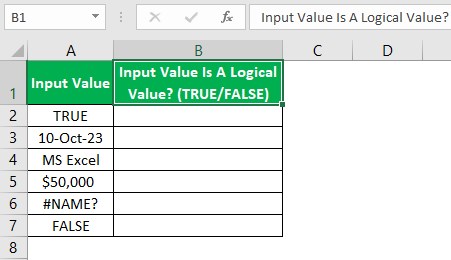
The task is to determine which of the given values are logical values, TRUE or FALSE and display the output in the corresponding cells in column B.
Then, we can apply the ISLOGICAL formula in each target cell to achieve the required data.
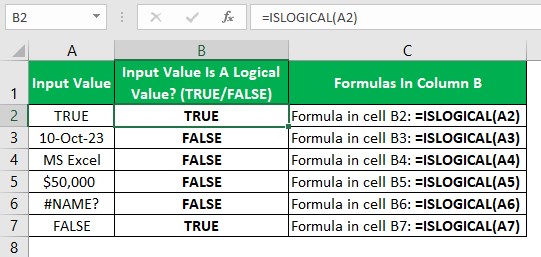
In the above ISLOGICAL formula example, the ISLOGICAL() accepts the reference to the cell containing the value we must check in the corresponding row.
The ISLOGICAL function then returns TRUE if the value in the specified cell is a logical TRUE or FALSE. Otherwise, the function returns FALSE as the output.
Furthermore, the ISLOGICAL function for both Mac and PC works according to the above mentioned logic.
Table of contents
- The ISLOGICAL function accepts a value and returns TRUE if the supplied value is logical. Otherwise, it returns FALSE. The input can be a valid value, logical value, error value, or a formula returning a value or logical value.
- Users can utilize the ISLOGICAL Excel function for checking formulas for potential errors, data validation, and sorting data based on logical values.
- The ISLOGICAL Excel function accepts one mandatory argument value, value.
- While we can apply the ISLOGICAL Excel function as a standalone function, using it with other inbuilt functions, such as IF and other IS Excel functions, yields fruitful outcomes.
Syntax
The syntax to apply while using ISLOGICAL function is the following:

Where,
- value: The data we aim to check if it is a logical TRUE or FALSE.
The argument in the ISLOGICAL function is mandatory, and it can be a logical value, text, number, error value, cell reference, or a range referring to these values.
How To Use ISLOGICAL Excel Function?
We can utilize the ISLOGICAL function in two ways:
- Access the function from the Excel ribbon.
- Enter the function into the worksheet manually.
Method #1 – Access The Function From The Excel Ribbon
Choose a cell to calculate and display the output - The Formulas tab - The More Functions down arrow - The Information function group right arrow - ISLOGICAL function.
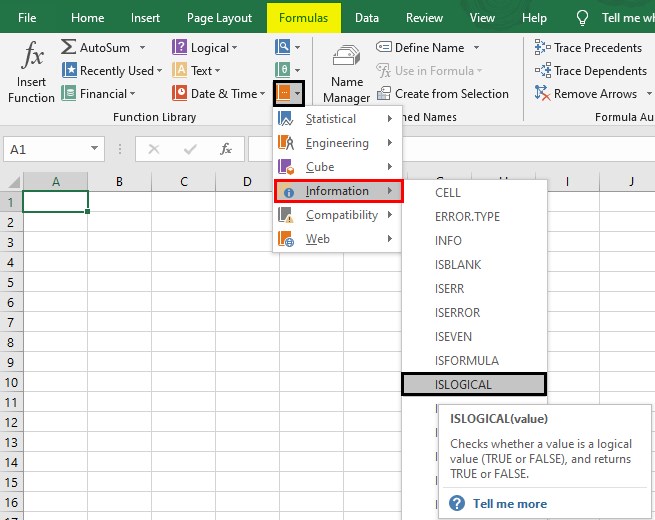
The Function Arguments window will be opened. Update the argument in the Value field.
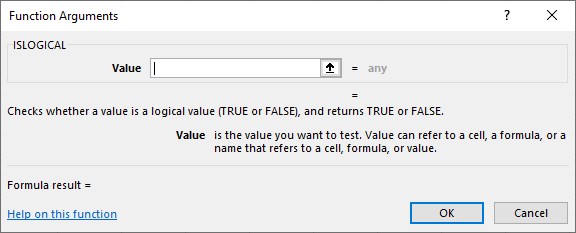
Finally, clicking OK in the Function Arguments window will help us view the ISLOGICAL function return value in the target cell.
Method 2 – Enter The Function Into The Worksheet Manually
- Choose a cell to display the output.
- Type =ISLOGICAL( in the cell.
- Enter the argument as a value, cell reference, or formula and close the brackets.
- Press Enter to view the ISLOGICAL() output.
Please note that the above methods work for the ISLOGICAL function for both Mac and PC.
Examples
The following ISLOGICAL function examples will help utilize the function effectively.
Example #1
The following dataset contains a list of values and their data types.
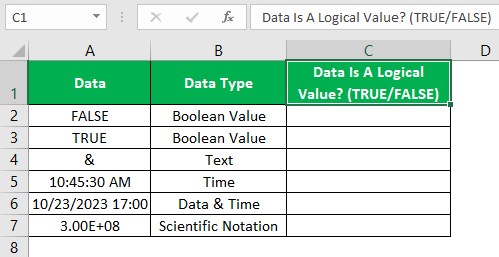
The aim is to determine if the values in column A are logical or Boolean values and display the output as TRUE or FALSE in the corresponding cells in column C.
Then, here is how to obtain the required data using ISLOGICAL function in each target cell.
Step 1: Choose cell C2, enter the ISLOGICAL function, and press Enter.
=ISLOGICAL(FALSE)
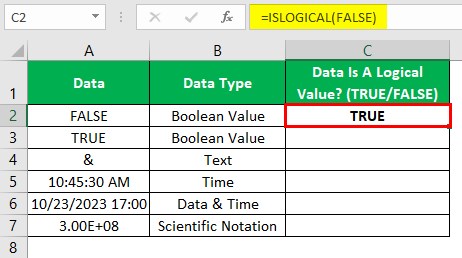
Supplying the argument value as a reference to the cell containing the value we aim to check in the ISLOGICAL function will give the same output.
=ISLOGICAL(A2)
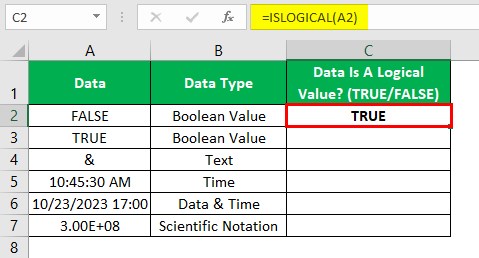
Step 2: Using the Excel fill handle, update the ISLOGICAL function in the remaining target cells.
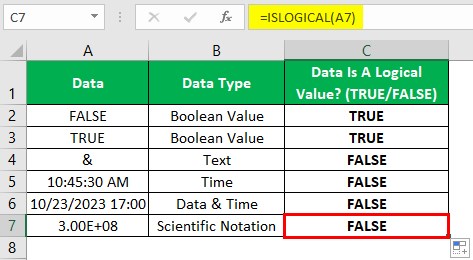
On the other hand, when we supply a Boolean value in double quotes to the ISLOGICAL() as the argument value, the function treats it as a text value. Hence, the function returns FALSE, as depicted below:
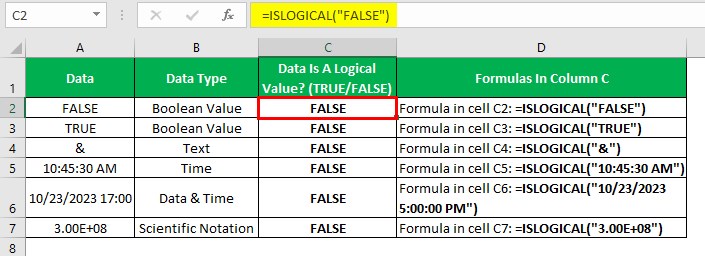
Example #2
The dataset below contains different formula outputs in column A.
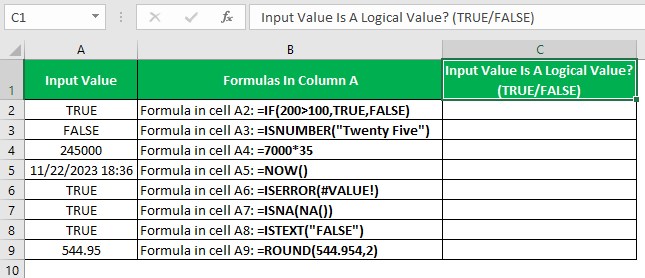
The task is to find out the formula outputs that are logical values and display the result in column C.
Then, here is how to apply the ISLOGICAL function in each target cell to achieve the desired outcome.
Step 1: Choose cell C2, enter the ISLOGICAL function, and press Enter.
=ISLOGICAL(A2)
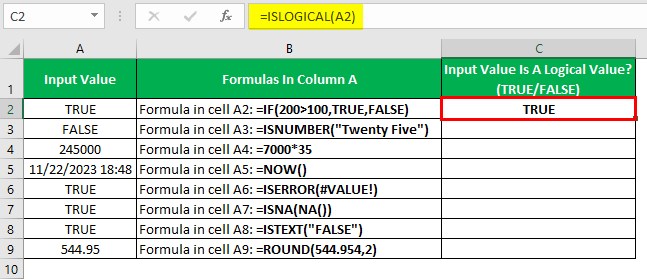
Step 2: Using the fill handle, implement the ISLOGICAL() in the remaining target cells.
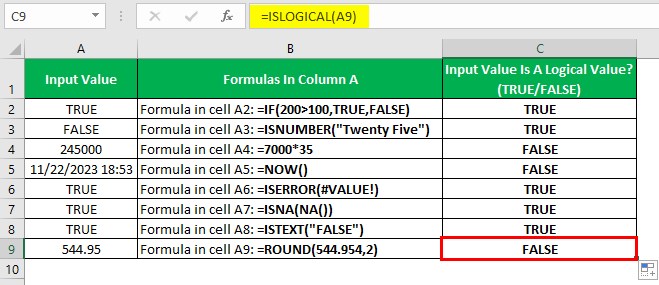
Let us check the cell C9 formula to understand the logic.
First, the ROUND() returns the value after rounding off the input value 544.954 to two decimal places, which is 544.95. Next, the ISLOGICAL() accepts the ROUND() return value as the input and checks whether it is a logical value. Since the value 544.95 is not a logical value, the ISLOGICAL() output is FALSE.
Example #3
Let us see how to use the ISLOGICAL function for data validation.
The dataset below contains comments in column A.
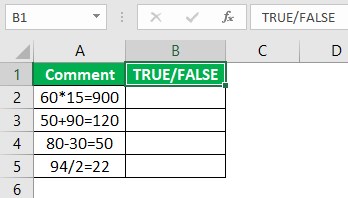
The aim is to update whether the comment is true or false in column B. Also, we can only enter TRUE or FALSE in column B cells. Otherwise, Excel must warn us to enter only TRUE or FALSE in the target cells.
Then, here is how to use the ISLOGICAL function with the Excel Data Validation feature to achieve the desired outcome.
Step 1: Choose cells B2:B5 and select Data - Data Validation - Data Validation.
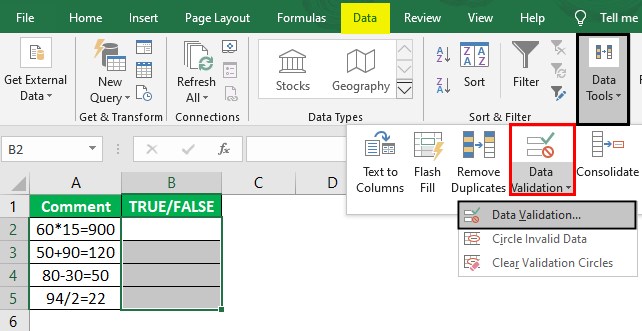
The Settings tab within the Data Validation window opens. Click the Allow field drop-down button to choose Custom from the drop-down list.
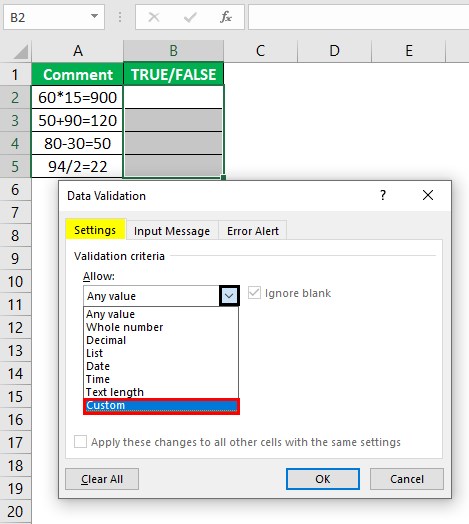
Next, update the following ISLOGICAL() formula in the Formula field.
=ISLOGICAL(B2:B5)
After that, click the Input Message tab to open it.
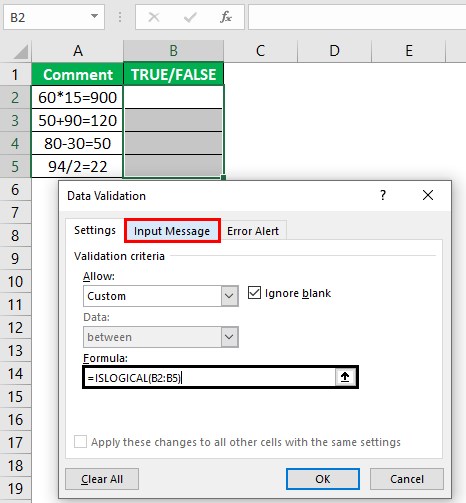
Step 2: Update the Title and Input message fields to guide the user to enter the required data in the chosen cells.
Next, click the Error Alert tab to access it.
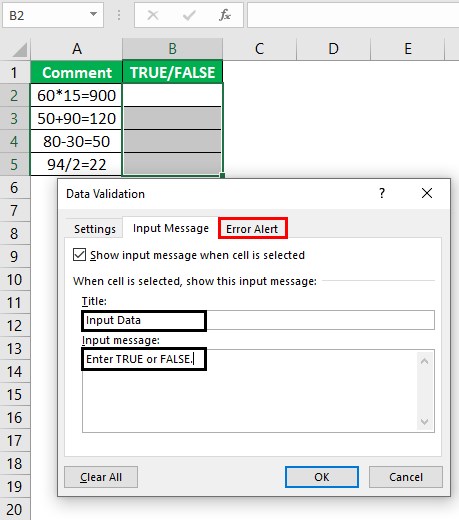
Step 3: Update the Title and Error message fields with the data to show as a warning message to the user when they enter a value other than logical values in the chosen cells.
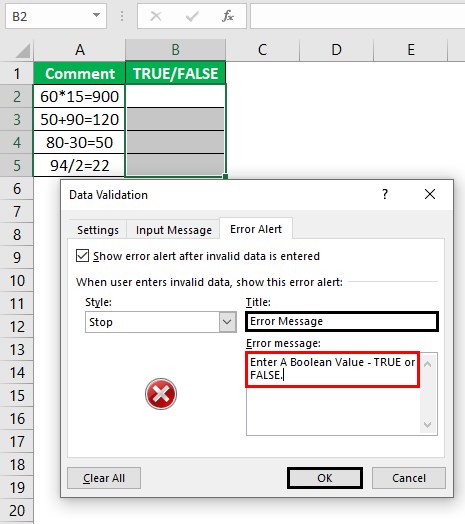
Click OK to exit the Data Validation window.
The input message is visible since the required cells are chosen.
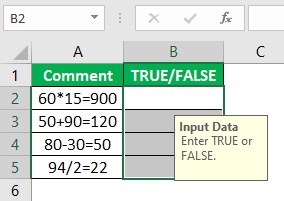
Step 4: Enter the appropriate logical value in cell B2 and press Enter.
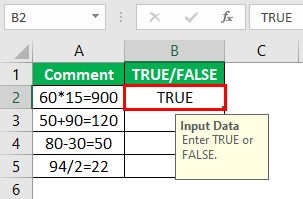
Next, assume we enter “No” instead of the required FALSE value in cell B3.
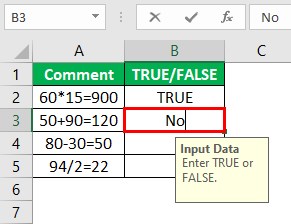
On pressing Enter, Excel will show the Error Message box, stating to enter a Boolean value, TRUE or FALSE.
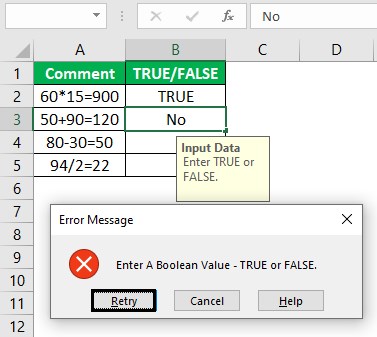
Step 5: Clicking Retry in the Error Message box will insert the cursor into cell B3, enabling us to update the required logical value in the specific cell.
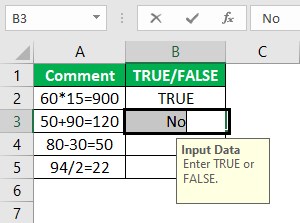
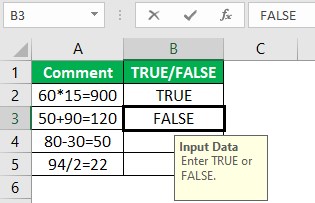
Finally, press Enter and continue entering the appropriate logical values in the remaining target cells.
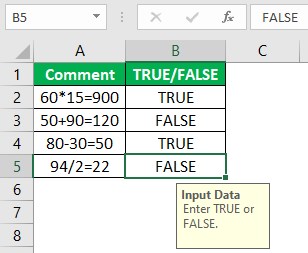
Since we used the ISLOGICAL function in the Formula field in the Data Validation window, the function ensures that we can only enter the logical values in the chosen cells. Otherwise, Excel asks us to update the appropriate logical values in the specific cell.
Important Things To Note
- Ensure to supply an error-free value argument value to the ISLOGICAL function in Excel. Otherwise, the function return value will be the Excel #VALUE! error value.
- The ISLOGICAL Excel function does not consider 1 and 0 as logical TRUE and FALSE.
- The ISLOGICAL Excel function does not consider TRUE or FALSE supplied in double quotes as logical values.
Frequently Asked Question (FAQs)
The ISLOGICAL Excel function in VBA example is as follows:
The following dataset lists values in column A.
We can check if the values are logical values using the IsLogical method in Excel VBA and display the output in column B.
Step 1: Let the sheet containing the source dataset be the active sheet, and press Alt + F11 to open the VBA Editor.
Step 2: Choose the required VBAProject and select Module from the Insert tab.
A new module window opens.
Step 3: Type in the VBA code to apply the ISLOGICAL() in all the target cells.
Step 4: Press the play icon in the menu to execute the code.
Now, when we open the active sheet, we will see the ISLOGICAL() applied in every target cell.
The ISLOGICAL() in each target cell accepts the input value in the corresponding row and checks whether the value is logical. If the value is logical, the function returns TRUE, else FALSE.
The common mistakes when using ISLOGICAL() in Excel formula are as follows:
• The supplied argument value is not proper.
• Confusing the ISLOGICAL() with other IS Excel functions.
• Expecting the ISLOGICAL() to return TRUE for values assumed to be logical values.
Your ISLOGICAL isn’t working because of the following reasons:
• The function name is incorrect.
• The supplied argument value is an invalid cell reference, value, or formula.
• The formula supplied as input to the ISLOGICAL() is incorrect and contains errors.
Download Template
This article must be helpful to understand the ISLOGICAL Function, with its formula and examples. You can download the template here to use it instantly.
Recommended Articles
This has been a guide to What Is ISLOGICAL Function. Here we learn the ISLOGICAL Excel function syntax and how to use it with examples & points to remember. You can learn more from the following articles –
